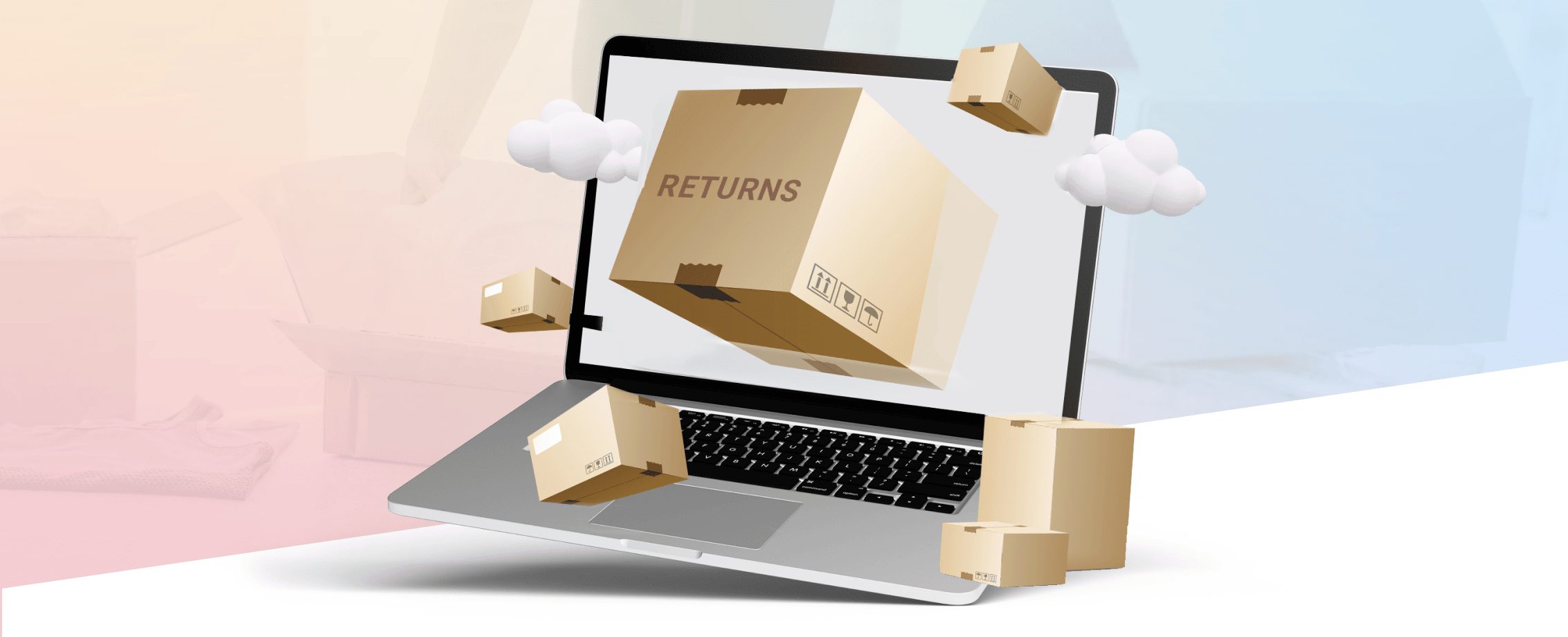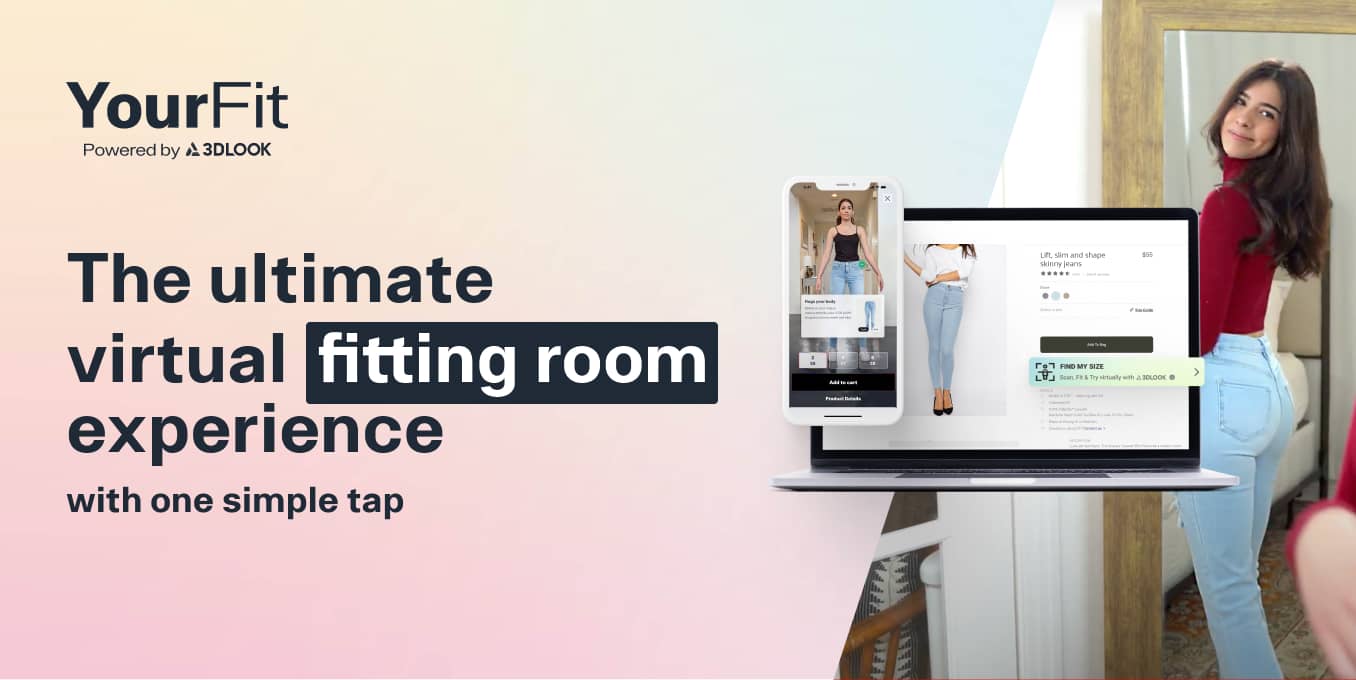Ecommerce offers access to a wide pool of potential customers and at a far cheaper cost than maintaining a physical store, with added convenience that encourages spending. But there’s also one glaring challenge that holds businesses back: unwanted purchases — and the issue will only get worse if online retailers don’t figure out how to handle ecommerce returns soon.
Every retail sector has to deal with returns, but apparel ecommerce has it particularly tough. Whereas customers shopping in-store can inspect a product for damage, try on different sizes and make sure it matches their look, online shoppers typically have little more than a few photos, a short description and confusing sizing charts to go on.
Each year, US shoppers return an estimated 3.5 billion items of clothing according to Optoro, but what percentage of apparel returns happen online? Let’s do the math.
The National Retail Federation estimated 12.2% of apparel purchases are returned, which would put total sales at 28.69b. Ecommerce sales make up roughly 14% of total retail sales, which equates to 4.02b items. With customers shipping back 20.8% of their online apparel purchases, that means 835m products (or 23.8% of all apparel returns) are sent back each year.
It’s not a majority, but it is a problem. Online shoppers are three times more likely to return a purchase and, with the apparel ecommerce market growing at an average rate of 14.2% according to Statista data, return rates will likely follow a similar trajectory without improvements.
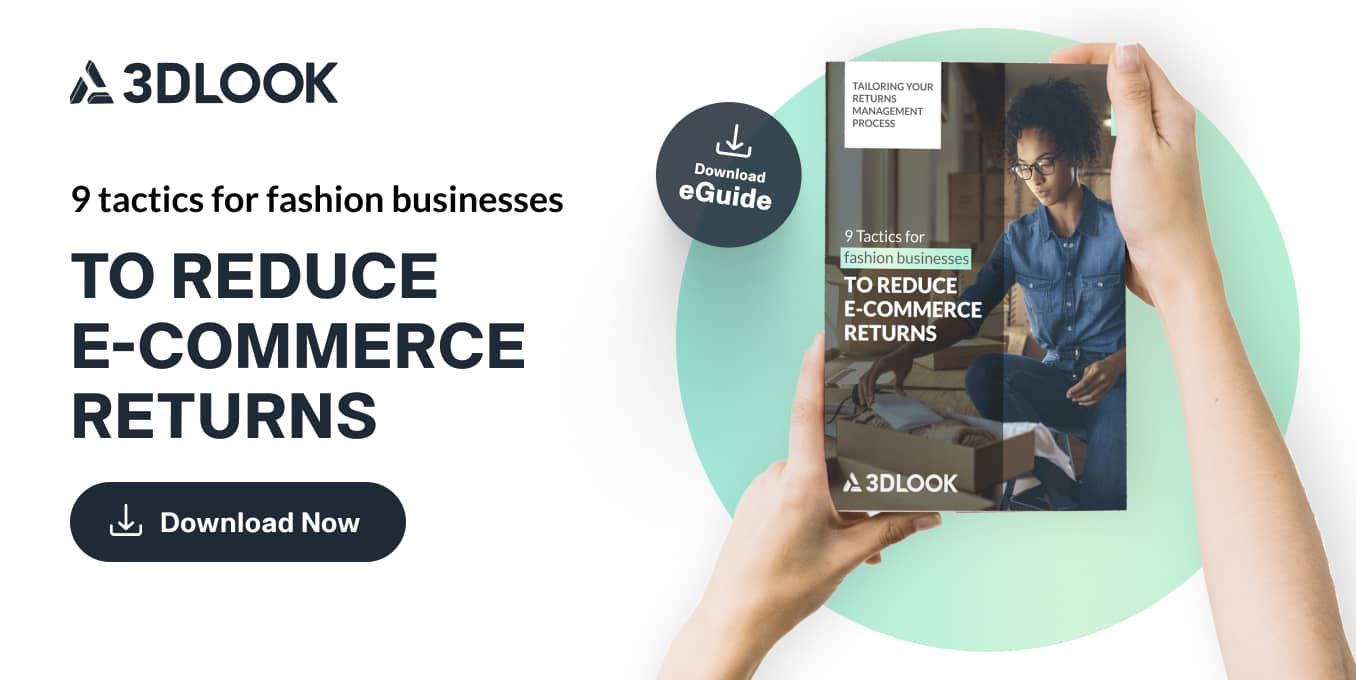
Why is it important to reduce ecommerce returns?
As long as unwanted products are returned in perfect condition, they can simply be resold, right? What’s the big deal? Well, you’ve paid for shipping twice, your warehouse staff have wasted hours and fashion’s fast-moving trends means you’re unlikely to sell it again at full price.
For every $50 item that gets returned, retailers face losing 39% of its value… and that’s on a good day. In worse cases, discounts, logistics, processing and customer service costs can total $49.50, and attempting to resell it would be pointless.
For those operating an online clothing store, knowing how to handle returns is important to protecting the bottom line, but that isn’t the only issue. Items deemed unsuitable for restocking are either sold on to discounters at a fraction of their original value or shipped off to landfill at the expense of our planet. According to Optoro and the Environmental Capital Group research, 5.8 billion pounds of returned stock is thrown away annually, but only once it’s traveled around the country, releasing 16 million metric tons of carbon dioxide into the atmosphere each year. With 85% of consumers having abandoned a purchase over sustainability concerns, according to Exasol, apparel brands must find a way to cut this environmental cost.
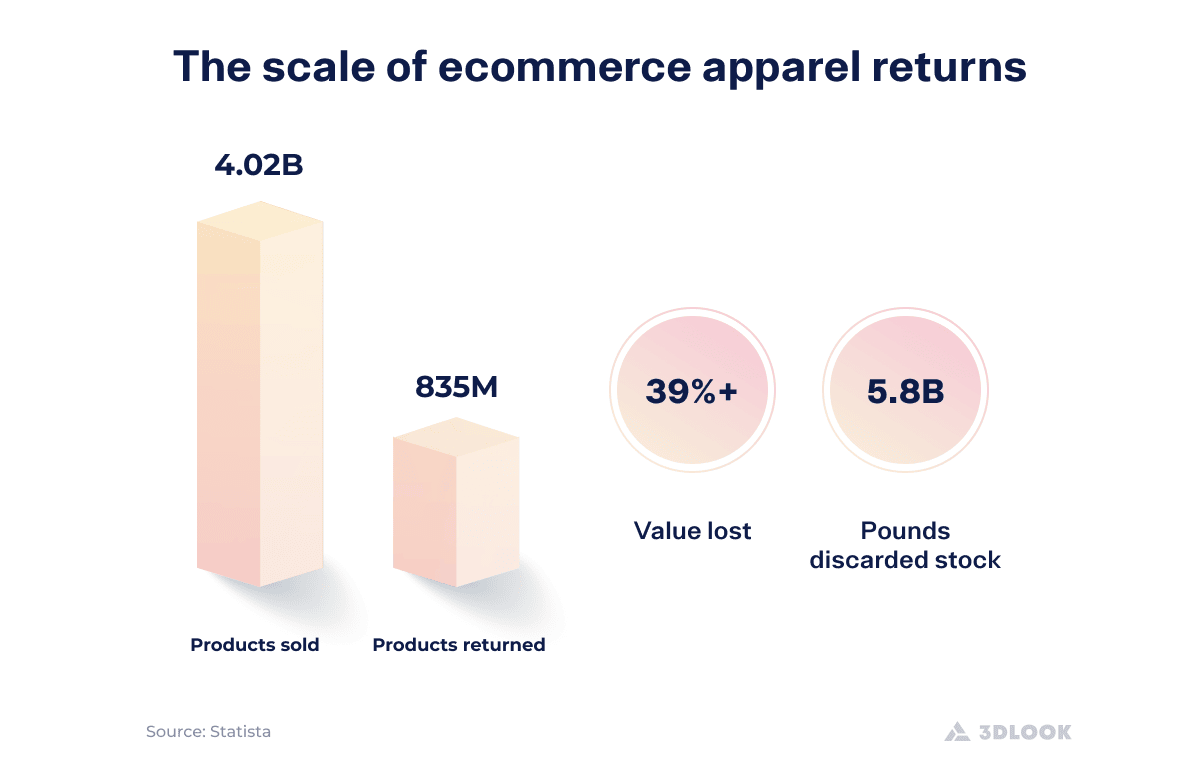
Ecommerce returns best practices: How to handle customer returns effectively
According to Sorted, 44% of shoppers won’t reorder from a retailer if they experienced issues during the returns process in the past. With a recent Doddle survey finding 74% of consumers feel retailers’ return processes need improvement, many returns aren’t just costing you a sale. There’s a high chance you’re losing a customer too.
By learning how to handle ecommerce returns and optimizing the entire returns process, retailers can save themselves time, money and customers.
Pre-purchase
Retailers should be thinking about returns long before the request arises. Rather than focusing solely on managing the issue, stores should proactively try to minimize rates by addressing the most common causes of returns: size and fit (38%), appearance & style (15%), poor quality (14%) and product faults (13%) according to Statista.
Unlock the virtual fitting room
Digital sizing tools can help customers to find their right size no matter where they’re shopping from.
However, not all sizing solutions are created equal. For instance, quiz-based solutions that require customers to answer questions about their body dimensions, fit preferences and past purchases are reliant on them answering honestly and objectively. Any inaccuracies will lead to incorrect sizes and chances are the customer will send it back.
To reduce returns, what retailers need is an AI-based solution such as YourFit, which captures photos through the customer’s smartphone and accurately calculates their body measurements using AI algorithms. Combining size recommendations with a photorealistic virtual try-on tool that lets customers see items on their own body, the solution eliminates many of the issues that lead to ecommerce apparel returns.
Within six months of implementing YourFit, inclusive swimwear brand TA3 SWIM was able to cut size-related returns in half — Get in touch to learn more about the return-reducing benefits of YourFit!
Improve your product pages
How will shoppers know what you expect from your products if you don’t show and tell them? Providing detailed product descriptions and high-quality imagery that make it clear exactly what the customer will receive is a must.
For instance, as well as the important specifications such as size, fit and materials, Net-a-Porter also includes ‘editor notes’, which provide background on the brand and manufacturing methods, as well as helpful style tips.
Don’t do too little, but don’t do too much either. Your products will always fall short of expectations if your descriptions bend the truth and your imagery doesn’t reflect reality.
Carry out regular audits
The odd product defect is expected, but if it’s a frequent source of returns, maybe it’s time to check in on your manufacturing, processing and logistics partners. Frequent audits can help to identify ineffective machinery and heavy-handed processes that are causing this spike in defective returns.
As well as cutting out the cause, audits can also help to maintain the bond between customer and brand on those few occasions when a return is unavoidable. Industry leaders such as ASOS, for instance, use unannounced factory audits as a way to evaluate the working conditions of those producing their products. According to CGS, 32% of consumers believe that ethical labor practices should be brands’ top priority and ensuring this desire is met could convince unsatisfied customers to give you another try.
Return requested
In 2021, ecommerce sales in the US surpassed $1 trillion, but $218bn worth of online purchases were shipped back. Clearly, knowing how to handle customer refunds and returns effectively matters.
Eliminating returns entirely is an unattainable goal given that shoppers often return goods simply because they changed their mind. However, with Klarna research showing 84% will turn their back on a retailer following a single unsatisfactory returns experience, it’s important to optimize the process to limit business impact.
Craft your returns policy
With 67% of shoppers checking the returns page before making a purchase, according to Invesp, a transparent returns policy that clearly defines what customers can expect regarding deadlines, product condition, shipping costs and refund times is vital. This way, there are no surprises and the chance of frustrations materializing is reduced.
Often, lenient return windows perform better as shoppers aren’t rushed into making a decision. However, offering a longer return period for exchanges could help to retain a larger chunk of the order value. For instance, Bonobos gives its customers 45 days to return an item for a refund or 90 days to return it for store credit.
Listen to your customers
Here’s some good news: Research by Narvar found 95% of consumers would happily shop with a brand again following a positive returns experience. However, tthis often requires a personal touch and a show of empathy.
Instead of issuing a refund and sending the customer on their way to a competitor, hear their concerns and ask them how you can make it right. Then do it. It might cost you, but retaining that customer will be worth far more to you in the long run.
Just look at Nordstrom, which is celebrated by consumers for its lenient returns policy. No matter when an item is returned, whether it’s been worn or whether the customer still has the receipt, the retailer considers every request on a case-by-case basis to keep shoppers happy.

Automate the request process
For those customers that prefer contact-free returns, streamline the process as much as possible. According to Rebound Returns, as many as 54.8% of return forms are either filled incorrectly or not filled at all. It’s just too much hassle, so pre-fill customer and product information, and provide checkboxes for them to state their return reason.
Take Amazon, for example. It didn’t reach the top by frustrating its frequent customers with an interrogative return process. You select the item, tick some boxes and within seconds you have a return label, ready to print and ship your unwanted goods back. The ecommerce giant offers no resistance and, with no bad feelings left behind, it’s only so long before you place another order.
Reward those that exchange
Return doesn’t necessarily mean refund. Encouraging customers to exchange instead allows retailers to retain some of the revenue, while presenting an immediate opportunity to prove that the issue was a one-off.
We all return purchases every once in a while and we shouldn’t be punished for doing so. Instead of making life difficult for those that would prefer a refund, brands such as Chubbies Shorts reward those that choose to exchange. Sure, incentives such as discount codes and account credit will cost you, but that happy customer will pay you back in the long run.
Return shipping
Receiving an online purchase that isn’t quite what you expected is annoying enough as it is. Needlessly complicating the process won’t prohibit them from returning their unwanted goods, but it’s a guaranteed way to convince them never to shop with your brand again.
Pre-fill return labels
Retailers are often advised to pre-print return labels and include them in the packaging when an order is shipped out. Sure, it saves customers some time, but retailers have to print a label for every order (which comes at a cost) even though the majority will go unused.
And how many of them will be discarded as general garbage, adding to the mountain of waste that fashion already leaves behind? This hardly aligns with the values of today’s environmentally-conscious consumers.
Instead of pre-printing labels, allow customers to download and print them pre-filled from their account dashboard. Not only will you be doing the planet a solid, but it offers an opportunity to get customers back to your store — and according to UPS, 45% will end up making an additional purchase.
Offer flexible options
According to Happy Returns, 18% of shoppers would prefer to pack up and ship off returns themselves, while 28% would prefer to schedule a pick-up. The remaining 54% wish to drop off their unwanted items at a physical store. Customers want different things and retailers must provide for them all by offering a variety of return options.
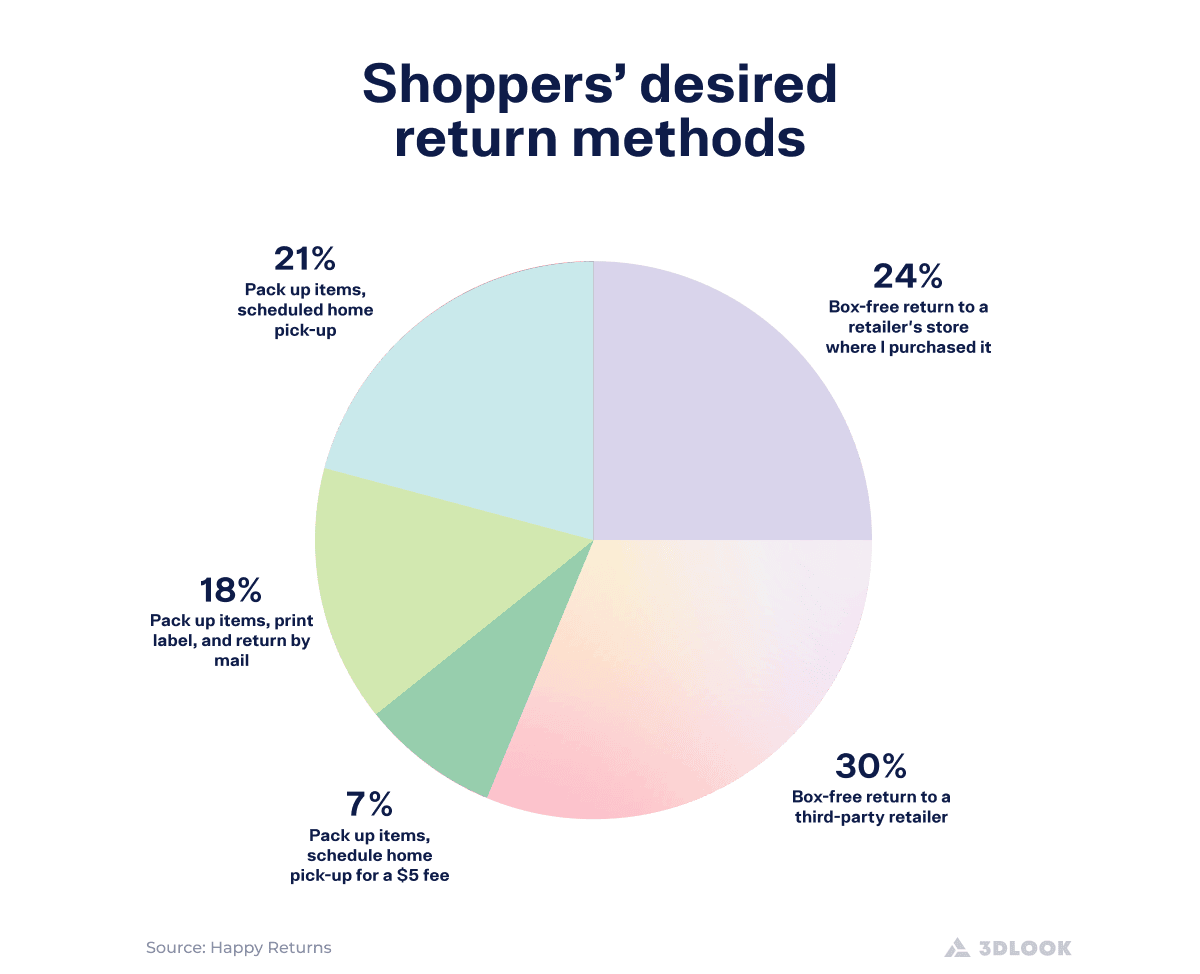
Modern consumers also need a sustainable choice. Aware of the damage returns cause, 87% would prefer to use sustainable shipping options when offered by retailers, according to ReBound. Farfetch, for instance, offsets the carbon footprint of all of its deliveries and returns by investing in environmental projects that balance out the environmental cost of every shipment.
Don’t make it free
Some 62% of shoppers say they won’t buy from a retailer that doesn’t offer free returns. Going against this sounds like a sure-fire way to put yourself out of business, and yet retailers such as Zara, Anthropologie and LL Bean have recently done just that. In fact, according to GoTRG, 60% of retailers are thinking about changing their policies, 67% of which are considering charging an additional shipping or restocking fee for returned goods.
It sounds counterintuitive. Yet, by scrapping free returns, retailers can reduce their expenses and pass the savings on to customers. Or, these savings could be spent on innovations that enhance the customer experience.
If you really think about it, free return policies are a safety net for shoppers. If retailers can find an alternative way to increase a customer’s confidence that an item will meet their needs and expectations BEFORE they make the purchase, they likely won’t even bother to check whether there’s a cost.
This is exactly what YourFit does — Customers can see that an item will fit them perfectly and look great on their body before it arrives at their door, giving them the confidence to checkout without relying on lenient return policies.
Return processing
Before a refund can be issued, processing staff will first need to inspect items for dirt and damage. Does the condition match the stated return reason? Does it appear to have been worn or washed? If dirty or damaged, was this caused by the customer? This is vital to protecting against return fraud – when customers purchase with the intent of abusing return policies, such as by using clothing and then shipping it back – but it also delays the process, causing friction between customer and brand.
Don’t take too long
Some 60% of customers expect a refund within three days of returning a purchase, ReBound data shows, so it’s vitally important to streamline the process. According to Happy Returns, rates may rise as high as 40% in the wake of Christmas as shoppers return unwanted gifts, so plan accordingly for spikes during the busy seasons.
If you lack the time and resources to keep returns moving along the chain efficiently, a returns management partner may be required. Third-party logistics (3PL) providers process, restock and dispose of goods returned to their sorting facilities based on your policies, offering a speedy, efficient and scalable returns processing.
Keep customers informed
Just like shoppers want to know when their order is processed, shipped and delivered, they also want to know when their return is received, processed and resolved. Retailers must keep customers informed through regular status updates via email, SMS or messenger apps, as well as by offering tracking information — which 44% of shoppers believe is a vital part of a good returns process.
Market-leading ecommerce retailers such as Amazon, Ebay and Flipkart work with third-party partners such as ZigZag, which ensures customers are provided a smooth experience by allowing customers to track the bulk of the returns they process.
If retailers fail to keep customers well informed, any bottlenecks are likely to put additional pressure on your customer service team. Costing $0.30 for every minute unhappy customers spend on the line, any chance of recouping your costs will rapidly decrease.
Post-return
All that data you collected throughout the returns process? Now it’s time to put it to good use. Returns are an invaluable learning opportunity and, used effectively, there’s potential not just to reduce losses, but to upsell and inspire life-long customers.
Identify patterns and optimize
Most retailers use data to improve their product offerings and enhance the customer experience. YourFit customers, for instance, can utilize Body Shape Analytics to tailor designs, shapes and sizes according to the body data of those that purchase their products.
Similarly, returns data is a goldmine and one that retailers too often leave untapped. Analyzing this data can unearth patterns that help you to identify the problems causing returns — Item not as described? Perhaps your product page needs refining. Product defects? An audit of your manufacturer might be in order. Incorrect size? Maybe you do need that virtual fitting room after all.
Challenge problem shoppers
From those frequently sending back worn goods to bracket shoppers that purchase multiple sizes knowing they won’t keep them all, these are the customers making ecommerce apparel returns unsustainable. If you’re keeping track of returns effectively, they shouldn’t be too hard to spot.
Retailers such as Amazon, JC Penney and Victoria’s Secret keep databases of problematic customers, suspected of return fraud based on their purchase and return history. When the cost of serving these customers becomes too much, they’re blocked from making further purchases. As they should be. However, don’t be too hasty — Many shoppers are unaware of the harm they’re causing and will likely change if given a warning.

How to handle returns on Shopify: Simplified ecommerce return management
Allowing anyone with an internet connection to establish their own ecommerce store, Shopify is used by millions of retailers to sell their products online. The platform makes setting up and managing a store simple, yet its standard return management process leaves plenty to be desired.
You receive a return request and login to see what the problem is. You compare the return reason against your policy and decide whether to grant the request. You fill in the details, purchase a shipping label and send it to the customer. Then you move on to the next one and, before you know it, that time you put aside to update your product pages or create marketing content has disappeared. Or, you could let automation do the heavy lifting…
Thankfully, Shopify’s thriving user base has attracted a marketplace full of developers creating useful plugins. With the right set of tools, Shopify store owners can streamline the entire returns process — for themselves and for customers.
Using return management plugins to handle ecommerce returns, Shopify users can automate decisions based on predefined rules, target customers with value-retaining offers, generate return labels, gather feedback and provide status updates (without lifting a finger).
Alternatively, retailers could always save themselves the trouble of dealing with sky-high return rates by implementing a solution that tackles the leading causes of apparel returns — YourFit customers can effortlessly integrate with Shopify via widget or API and start reducing their return rates in as little as five weeks!
Returns are inevitable, but not unmanageable
Too often, retailers discount high return rates as one of business’s many expenses. They’re not wrong, but when you’re looking for warehouse space or searching for a manufacturing partner, do you accept the first price you’re given or do everything possible to minimize the expense? Those that learn how to handle ecommerce returns efficiently and effectively will be rewarded not only financially, but also with greater customer loyalty, confidence and satisfaction.
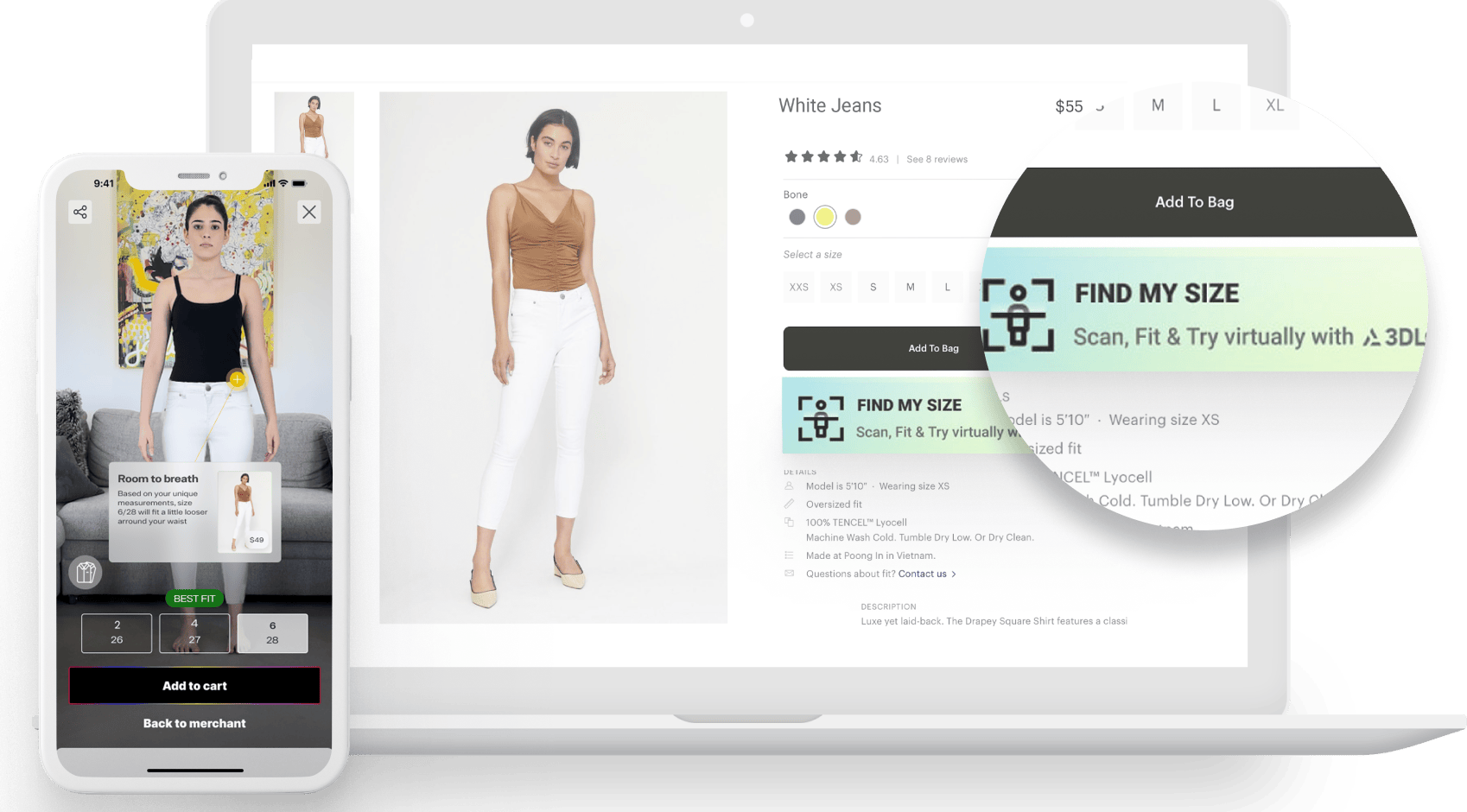
YOURFIT
A simple, user-friendly, and intuitive fit personalization platform that helps shoppers find the best size clothing while also providing an engaging try-on experience!
